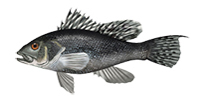Thank you for visiting the Seafood Selector. EDF is planning a new approach to providing information to consumers about good seafood choices. Please come back soon for updates.
Sea bass

Black sea bass
Recommended servings per month
| Contaminant | Men | Women | Kids 6-12 | Kids 0-5 | |
|---|---|---|---|---|---|
| Black sea bass (trap-caught, handline) | Mercury | 4 | 4 | 4 | 4 |
| Black sea bass (trawl-caught) | Mercury | 4 | 4 | 4 | 4 |
| European Sea Bass (farmed) | Unknown |
Eco details:
This popular species, prized by both commercial and recreational fishermen, is divided into two fisheries.
The North Atlantic population is in the process of rebuilding.
The South Atlantic population remains severely overfished. Both fisheries use bottom trawls, which have high rates of bycatch and habitat damage.




